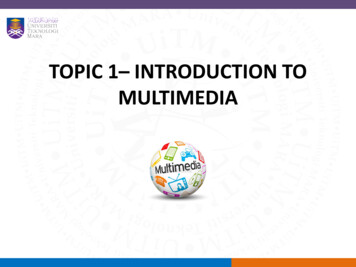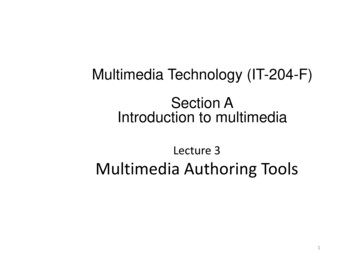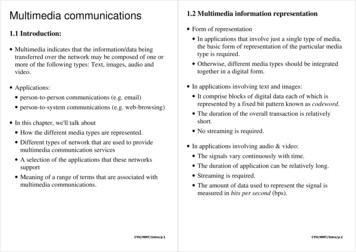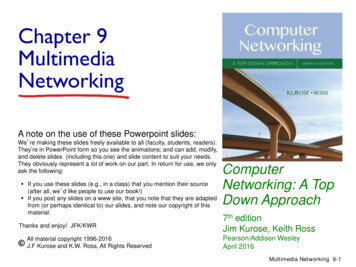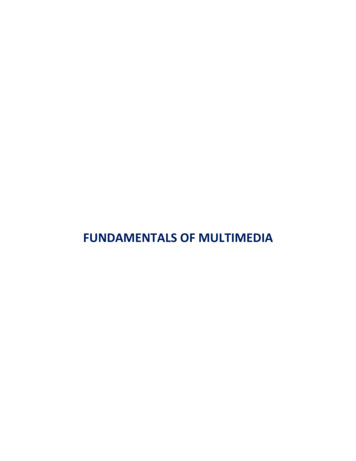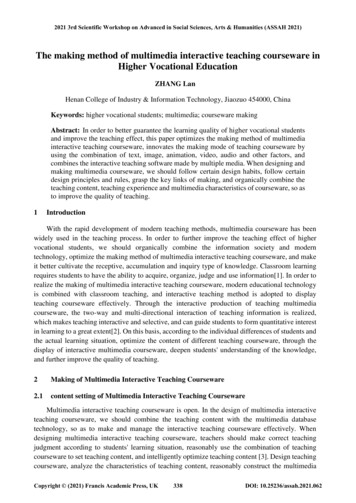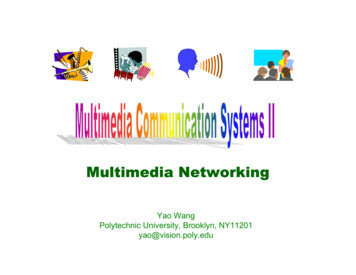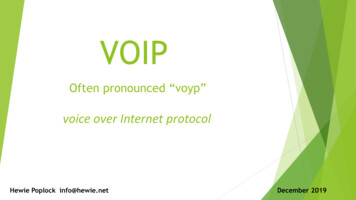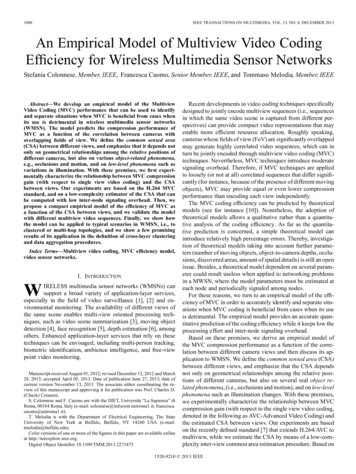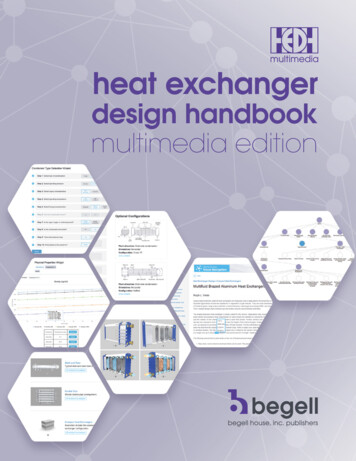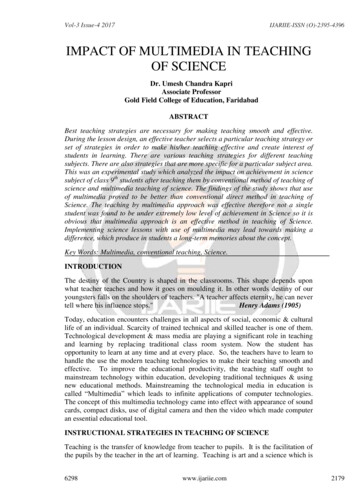
Transcription
Vol-3 Issue-4 2017IJARIIE-ISSN (O)-2395-4396IMPACT OF MULTIMEDIA IN TEACHINGOF SCIENCEDr. Umesh Chandra KapriAssociate ProfessorGold Field College of Education, FaridabadABSTRACTBest teaching strategies are necessary for making teaching smooth and effective.During the lesson design, an effective teacher selects a particular teaching strategy orset of strategies in order to make his/her teaching effective and create interest ofstudents in learning. There are various teaching strategies for different teachingsubjects. There are also strategies that are more specific for a particular subject area.This was an experimental study which analyzed the impact on achievement in sciencesubject of class 9th students after teaching them by conventional method of teaching ofscience and multimedia teaching of science. The findings of the study shows that useof multimedia proved to be better than conventional direct method in teaching ofScience. The teaching by multimedia approach was effective therefore not a singlestudent was found to be under extremely low level of achievement in Science so it isobvious that multimedia approach is an effective method in teaching of Science.Implementing science lessons with use of multimedia may lead towards making adifference, which produce in students a long-term memories about the concept.Key Words: Multimedia, conventional teaching, Science.INTRODUCTIONThe destiny of the Country is shaped in the classrooms. This shape depends uponwhat teacher teaches and how it goes on moulding it. In other words destiny of ouryoungsters falls on the shoulders of teachers. "A teacher affects eternity, he can nevertell where his influence stops."Henry Adams (1905)Today, education encounters challenges in all aspects of social, economic & culturallife of an individual. Scarcity of trained technical and skilled teacher is one of them.Technological development & mass media are playing a significant role in teachingand learning by replacing traditional class room system. Now the student hasopportunity to learn at any time and at every place. So, the teachers have to learn tohandle the use the modern teaching technologies to make their teaching smooth andeffective. To improve the educational productivity, the teaching staff ought tomainstream technology within education, developing traditional techniques & usingnew educational methods. Mainstreaming the technological media in education iscalled “Multimedia” which leads to infinite applications of computer technologies.The concept of this multimedia technology came into effect with appearance of soundcards, compact disks, use of digital camera and then the video which made computeran essential educational tool.INSTRUCTIONAL STRATEGIES IN TEACHING OF SCIENCETeaching is the transfer of knowledge from teacher to pupils. It is the facilitation ofthe pupils by the teacher in the art of learning. Teaching is art and a science which is6298www.ijariie.com2179
Vol-3 Issue-4 2017IJARIIE-ISSN (O)-2395-4396a social act of influencing pupils by the teacher. It is doing anything that might leadto learning. According to N.L. Gage, (1963), “Teaching as an act of interpersonalinfluence aimed at changing the ways in which other persons can or will behave. Thusteaching is imparting knowledge or skill which involves doing all things that may leadto learning”.Multimedia provides a range of tools with a unique capacity to extend and enrichteachers‟ instructional strategies and students‟ learning in science. Multimedia can beused to connect students to other schools, at home and abroad, and to bring the globalcommunity into the local classroom. Computer programs can help students to collect,organize, and sort the data they gather and to write, edit, and present reports on theirfindings. A teacher uses instructional strategy that is designed to establish interactionbetween the teacher, student and the subject matter or any combination of these threedimensions. In teaching a teacher can use one or many of the undermentionedinstructional strategies in the classroom. Direct Instructional strategy: deals with Drill, Practice, Mastery learning,lecture and Demonstration. Indirect Instructional strategy: creating problems and engaging students inProblem solving or concept mapping. Interactive Instructional strategy: Co-operative learning and Brainstorming arethe best examples of Interactive Instructional strategy. Experimental Instructional strategy: The teacher engages the students inlaboratory in doing practical which are Activity-oriented or takes them Field Tripsfor the knowledge of various funna and flora and their specimen collection. Independent Instructional strategy: Computer Assisted Instruction, Learningand Activity Package etc. are the examples of Independent Instructional strategy. Computer-Assisted Instructional Strategy: Computer Assisted Instruction is amethod of learning in which there is purposeful interaction between a learner andteacher with the help of computer device for helping the learner to achieve thedesired learning objectives with his/her own pace. It helps in achievingeducational outcomes through internet, e-mail, CD‟s, video clips, virtual fieldtrips, virtual science museum and various other sources like e-learning. Conventional Instructional Strategy: Conventional based instruction is focusedon the instructor which is teacher centered. Most of the information tends to flowfrom teacher to students. Students are passive listeners. Teacher has authoritarianrole and transmit knowledge to the students.MULTIMEDIAMultimedia is nothing but the processing and presentation of information in a morestructured and understandable manner using more than one media such as text,graphics, animation, audio and video. Thus multimedia products can be an academicpresentation, game or corporate presentation, information kiosk, fashion-designingetc. Multimedia systems are those computer platforms and software tools that supportthe interactive uses of text, graphics, animation, audio, or motion video. In otherwords, a computer capable of handling text, graphics, audio, animation and video is6298www.ijariie.com2180
Vol-3 Issue-4 2017IJARIIE-ISSN (O)-2395-4396called multimedia computer. Technological innovation has accelerated in the firstdecade of the new century, with digital projectors as CD-ROMs or DVDsaccompanying many textbooks. Today, in good schools there are high-speed internetconnections in most classrooms that allow reasonable-quality video streaming, andmany students now bring wireless laptops, computers, or hand-held devices into theclassroom setting.The use of multimedia materials has substantial grounding in cognitive theory andresearch. Several studies indicate that computer-based multimedia can improvelearning and retention of material presented during teaching and learning ascompared to conventional teaching where study materials do not use multimedia.Multimedia presentations are most effective when the different types of media supportone another as teaching strategies which enhance students‟ learning.A well -developed multimedia can do more than good. The potential pedagogicalvalue and rationale for using multimedia in classroom is given below: To raise interest level: Multimedia raises the interest of the student in learningand they appreciate a variety of media.To enhance understanding: Multimediacomprehension of complex topics of science.materialsbooststudents‟To increase memorability: multimedia leads to better encoding and easierretrieval which confirms for long-term memory.Multimedia is an effective way for sending and receiving messages which can becomprehended easily and smoothly. The inclusion of media elements reinforces themessage and the delivery, which leads to a better learning rate. The power ofmultimedia lies in the fact that it is multi-sensory, stimulating the many senses of theaudience. It is also interactive, enabling the end-users of the application to control thecontent and flow of information (Vaughan, 1998). This has introduced importantchanges in our educational system and impact the way we communicate informationto the learners (Neo & Neo, 2000). Multimedia in Education has been extremelyeffective in teaching and learning of a wide range of subjects.A lecture can be extremely informative if it integrates pictures or video images whichcan help a learner to retain information much more effectively. Using interactive CDROMs can be extremely effective in teaching students a wide variety of disciplines,most notably science. Multimedia programs provide different stimuli in theirpresentations which include a number of elements as Texts, spoken words, sound &music, graphics, animations and still pictures. Inclusion of these elements in teachingin a comprehensive presentation provides effective education, which in turn willsupport the participation of the different senses of the learners in diverse syllabi.Media in teaching are classified with regard to the senses they stimulate. The mostcommon classification of media: audio, visual and audio-visual. With the arrival ofthe multimedia computer, the term multimedia is more frequently referred tocomputer multimedia. The necessities of using multimedia computers are appropriatecomputer equipment that works and computer literacy of the learner and the teacher.Multimedia in teaching shows the numerous possibilities of combining differentmedia in class work, successively and simultaneously, based on the existing needs fordevelopmental achievements of students. The Classic teaching resources include6298www.ijariie.com2181
Vol-3 Issue-4 2017IJARIIE-ISSN (O)-2395-4396verbal, textual, visual, auditory, audio-visual, manual, experimental and auxiliarytechnical educational resources, while modern teaching resources includeseducational program back-ups, multimedia electronic communication, expert systems,teaching bases of knowledge, intelligent tutorial systems etc. Therefore, with regard tothe type of sense, the information can be obtained as given below:1. Auditory – sources of knowledge which provides information by listening.2. Visual – sources of knowledge which provides information by watching.3. Kinaesthetic – sources of knowledge which provides information bymovement.4. Olfactory – sources of knowledge which provides information by smelling.5. Taste – sources of knowledge which provides information by tasting.The students acquire knowledge, develop skills and adopt pedagogical values. Theteaching content is determined by the curricula for each individual age of the student.Students along with the teacher are in a direct relationship, but in an indirectrelationship with teaching contents, which means that through the mediation of theteacher‟s lecture, they acquire contents. Multimedia is a teaching device andinstructional aid which can be bought, rented, formed for the needs of the class.Multimedia is not supplant the teacher, but serves as an excellent complement to thespoken word, blackboard, textbook, teaching transparencies, geographical maps etc.Moreover, multimedia is used in class interaction.NEED AND IMPORTANCE OF THE STUDYMethod of teaching is extremely important. However there is little realization of thisand the methods of teaching used in our schools, colleges and training institutescontinue to be largely traditional. According to „Challenge of education‟ published byMinistry of Education (Government of India) “Application of new technologies canconvert educational institutes into learning rather than teaching institutes with vastimplications for curricular and instructional methods” When imparting knowledge,every care should be employed in adopting effective teaching technique. We shouldprovide students with meaning and relevance and a comfortable and pleasantatmosphere to learn which is pressure free. Students need a sense of self-worth. Eventhe best curriculum and the most perfect syllabus remain dead unless supported by theright strategies of teaching. The search for educational effectiveness has always beena primary objective for the educators. In order to achieve educational effectiveness itis important for the educators to adopt an effective teaching method that suits theindividual learning style.Science has become a part of everyday experiences and thus there is a need to initiatethe students into the scientific spirit and to introduce them to a world made up oftechnological objects and processes where in multimedia plays a pivotal role. TheScience teacher creates situations in which students may explore the concepts seekingexplanations of the objects and events they observe discover relationship amongobjects and events. The teaching process can thus be made effective. A teacher canjudge students strengths and weaknesses through an activity. In our schools Scienceteaching is still oral in character where the students are passive listeners. The teachingof the subject can be made more interesting and effective if some innovative6298www.ijariie.com2182
Vol-3 Issue-4 2017IJARIIE-ISSN (O)-2395-4396methodology is adopted. Therefore, this research aimed to establish the impact ofmultimedia technology against conventional teaching method in teaching of scienceand achievement of students in science subject after that they were taught sciencesubject by conventional method and multimedia method. Multimedia is an effectivemethod of teaching Science which will enhance the academic achievement ofstudents.Multimedia provides the teacher with many possibilities in creating teachingstrategies. Using the internet, pupils quickly find the required information. Formats ofstored information are smaller in comparison with video cassettes (e.g. CD, DVD andUSB). Multimedia educational tools are conceived on the principle of play, asextremely powerful techniques of learning, making teaching easier etc. With regard tothe features mentioned, it can be concluded that multimedia represents a turning pointin improving teaching technology. So the researcher tried to find out Impact ofMultimedia in teaching of Science at secondary stage.STATEMENT OF THE PROBLEMThe title of the research is given as: “Impact of Multimedia in Teaching of Scienceat Secondary Stage”.OBJECTIVES OF THE STUDY1. To know how multimedia can help in improving pedagogical quality ofteaching in a classroom.2. To study the significant difference in the process of classroom teachingthrough conventional method and multimedia technology.3. To find out academic achievement of students in science subject by teachingthem in conventional method and using multimedia technology.4. To find out advantages using of multimedia technology in teaching of sciencesubject in the classroom.HYPOTHESES OF THE STUDY1. There is no significant difference between academic achievement in science ofstudents taught by conventional method and using multimedia technology withrespect to their post-test scores.RESEARCH METHODOLOGYThe present research work was based on experimental research. An experimentaldesign was used in which one section of the school acted as control group wheretraditional teaching method was applied. The other section was considered as theexperimental group which was taught through Multimedia technology.Population and Sample: Population for the present study comprised of the class9th students of a private school of Faridabad. Random sampling technique wasadopted for selection of a section of 20 students of class 9th as control group andanother section of 20 students of same class were taken as experimental group.6298www.ijariie.com2183
Vol-3 Issue-4 2017IJARIIE-ISSN (O)-2395-4396TOOLS USED1. An Achievement test in Science for class 9th students was prepared by theinvestigator to assess their achievement in Science at pretest as well as post-test.PROCEDURE OF DATA COLLECTIONAchievement test in Science for class 9th students prepared by the investigator wasadministered on the both control group and experimental group to assess theirachievement in Science at pretest. Lesson plans of selected topics in science subjectwere prepared then control group was taught the selected topics by conventionalmethod and the experimental group was taught by multimedia teaching. Both thegroups were taught for a period of three months. Further the achievement test inScience prepared by the investigator was administered on both the groups to knowtheir achievement in Science at post -test. Scores obtained from both the groups inpre-test and post- test were compared by applying statistical techniques. To finddifference of achievement in science between control group and experimental grouptheir post- test scores were compared by finding their critical ratio.STATISTICAL TECHNIQUES USEDStatistical techniques such as Mean, Standard Deviation, Z-score and t-Test wereused for analysis and interpretation of the data.DELIMITATIONS OF THE STUDY1. Only selected topics in Science were taken to teach the 9th class students.2. The study was delimited to 9th class students of a private school located aturban area of Faridabad district of Haryana only.ANALYSIS OF SCORES OF ACHIEVEMENT TEST IN SCIENCEThe graph-1 shows the number of students under the various levels of achievement inscience at pre-test and post-test from the control group of 20 students.65No. of Studentsat Pre-test43No. of Studentsat Post -test210Graph-1: Number of students from Control Group at various levels of6298www.ijariie.com2184
Vol-3 Issue-4 2017IJARIIE-ISSN (O)-2395-4396Achievement in Science at Pre-Test and Post-TestOn analyzing the pre-test and post-test scores of Achievement in Science of 20students of control group, it was observed that there was not significant increment ofstudents in post-test under extremely high, high and above average level ofachievement in science.The graph-2 shows the number of students under the various levels of achievement inscience at pre-test and post-test from a sample 20 students of experimental group.765No. of StudentsPre-test43No. of StudentsPost- test210Graph-2: Number of students from Experimental Group at various levels ofAchievement in Science at Pre-Test and Post-TestOut of 20 students of experimental group a large number of students scored goodmarks in achievement test in science at post-test and it was observed that not a singlestudent was found at extremely low level of Achievement in Science at post- test.Comparison of Post-Test Scores between Control Group and ExperimentalGroup in Science subject:Table- 1 shows mean, standard deviation and t-ratio of post- test scores ofachievement test in Science.Table 1: Comparison of post-test Scores of Achievement Test in Sciencebetween control group and experimental ol Group5.67Significant2031.33.67Experimental GroupThe calculated t-ratio of the post-test scores of achievement test in Science betweencontrol group and experimental group was calculated to be 5.67 which is statisticallysignificant at 0.05 and 0.01 levels of significance, so there exists a significantdifference between control group and experimental group with respect to their posttest scores of achievement in Science. Thus, it is concluded that there was a great dealof enhancement of Achievement in Science of students instructed through multimediatechnology. The multimedia teaching was effective as the result shows that the6298www.ijariie.com2185
Vol-3 Issue-4 2017IJARIIE-ISSN (O)-2395-4396students of experimental group scored better at post-test in achievement test inScience in comparison to their counterpart the students of the control group.MAJOR FINDINGSi. There was slight increment of level of Achievement in Science at posttest incomparison to the scores obtained at pre-test of control group of students whowere taught by conventional method of teaching of science.ii. There was tremendous increment of level of Achievement in Science ofexperimental group of students at post-test in comparison to the scoresobtained at pre-test. The use of multimedia in teaching of Science waseffective as the result shows that the students scored better at post-test inachievement test in Science.iii. Comparing both the methods with respect to the marks achieved by thestudents at post-test, it was evident that students performed better on post-testin comparison to pre-test, when they were taught using multimedia.iv. The multimedia technology was an effective technique of teaching of sciencesubject as the result shows that the students of experimental group scoredbetter at post-test in achievement test in Science in comparison to the studentsof controlled group who were taught by conventional methods of teaching.CONCLUSIONMultimedia method proved to be better than conventional method in teaching ofScience. When the controlled group students were taught some concepts of science bythe conventional method and experimental groups of the students were taught bymultimedia method, it was found that the achievement of experimental group wasbetter than the controlled group in post-test and the acquired retention was better incase of interactive multimedia method. The teaching by multimedia approach waseffective therefore not a single student was found to be under extremely low level ofachievement in Science so it is obvious that multimedia approach is an effectivemethod in teaching of Science. Multimedia allows teaching a simplified strategywhich leads to easy understanding on the part of the students. It raises the students‟academic achievement in Science subjects.EDUCATIONAL IMPLICATIONS OF THE STUDYThe findings of the study suggest that instruction through multimedia may be used toteach science and various other subjects at secondary stages. The study also impliesthat course could be completed in comparatively less time when taught throughmultimedia than conventional methods of teaching science and thus the spare time canbe utilized for more enrichment of educational activities. The below average studentsmay be compensated by teaching through multimedia. Teacher should be encouragedto prepare simple software package as children are more attracted toward coloredvisuals. Activity-oriented multimedia instructional strategy can improve competencycooperativeness, patience and develop dignity of labour among students.REFERENCE6298www.ijariie.com2186
Vol-3 Issue-4 2017IJARIIE-ISSN (O)-2395-43961. Agarwal, Y. P. & Manisha M., (1998). Effectiveness of Multimediaprogrammed learning and traditional methods of teaching. A meta-AnalyticalStudy on Indian Researches. Indian Education Review, Vol. 34, pp. 57-65.2. Ahluwalia,I. (1985); "A study of factors affecting achievement motivations",Ph. D (Psychology), Agra University, 1985.3. Best, J.W and Kahn, J.V., ( 2006). Research in Education, Prentice Hall ofIndia learning private limited, (New Delhi).4. Bhatt, B.C. (2002): A Study of effectiveness of Multimedia package on atomicstructure and chemical bonding. Dissertation, MJP Rohilkhand University,Bareilly.5. Buch, M. B; fourth survey of research in education, Volume I, 1983 - 88, page333.6. Capper, J. and Copple, C. (1985). Computer use in education: ResearchReview and Instructional Implications. Washington, DC : Centre for Researchinto Practice.7. Chandra, K. (1971). A study of the effective use of the facilities available inbiology teaching in higher secondary classes of Delhi Schools.8. Kulkarni, P.V. (1969): To prepare programmed learning material and to studyin what different ways it can be used, Ph.D. Edu., Poona University.9. Mallik, U. (2001). Computers in Indian schools: A road ahead. Journal ofIndian Education, Vol- XXVII, pp. 5-12.10. Mc Donald, D. S. (2004). The influence of multimedia training on users‟attitudes: lessons learned. Computer & Education, 42, 195-214.11. Mrogan, R. M. (1978). Educational technology - adolescent to adulthood,Educational Communicational and Technology Journal, 26, 142-185.12. Shashi , P. (2004).A study of the efficacy and appropriateness of the activitiesof Science text book in the light of skills and abilities of students , RIE, Ajmer.NCERT.6298www.ijariie.com2187
Vol-3 Issue-4 2017 IJARIIE -ISSN (O) 2395 4396 6298 www.ijariie.com 2183 Impact of Multimedia in Teaching of Science ".
